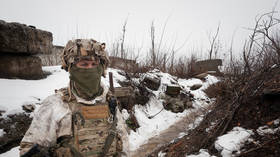The historic peace deal has yet to put an end to fierce fighting in the region
Seven years ago, on February 12, 2015, as a worsening armed conflict raged in the Donbass region of eastern Ukraine, European leaders, including then-German Chancellor Angela Merkel and former French President Francois Hollande, flew into Belarus for emergency talks. Following the negotiations, Russia, Ukraine, the leaders of the two breakaway separatist regions, and representatives of the intergovernmental organization OSCE inked their signatures on a pact known as Minsk II.
When it was signed, Russian President Vladimir Putin hailed the progress made, telling the media after the marathon summit, which lasted 17 hours, that “I believe we agreed on a big deal. We agreed to a ceasefire starting at 00:00 on February 15.” Under its terms, Ukrainian troops and separatist forces would put an end to the fierce clashes that had turned the region into a conflict zone.
The peace deal was signed after an earlier agreement, Minsk I, failed to bring any prospect of peace to the war-torn region. Seven years on, with some estimates claiming that over 14,000 people have died as a result of the conflict, Minsk II appears to have done little to calm tensions.
What are the accords? Fighting broke out in the Donbass following the events of Kiev’s 2014 Maidan, which saw the democratically elected government ousted in the wake of violent street protests, backed by the West. Separatists in the eastern regions of Donetsk and Lugansk subsequently announced their autonomy from Kiev and deployed forces that later clashed with the state’s troops.
Just months later, with the fighting still raging, representatives of Russia, Ukraine, the OSCE, and the leaders of the Donetsk and Lugansk republics signed Minsk II on February 12, 2015. The heads of state of France, Germany, Russia, and Ukraine were also present at the signing of the accords. “illegal,” and said they represented “yet another example of Russian subversive activity.” However, Kremlin Press Secretary Dmitry Peskov disputed that there were any violations to the accords. “Actually, the deplorable situation with the implementation of the Minsk package was provoked by Kiev’s unwillingness to fulfil the Minsk agreements,” he said.
Why is Ukraine being accused of rejecting the deal? A number of Kiev’s officials have expressed dismay at the terms set out in the Minsk agreements, which many say are weighted more in Moscow’s favor. In late January, the chief of Kiev’s National Security and Defense Council, Alexey Danilov, warned that their implementation could cause the country to collapse. The fulfillment of the Minsk agreement means the country’s destruction,” he argued. “When they were signed under the Russian gun barrel – and the Germans and the French watched – it was already clear for all rational people that it’s impossible to implement those documents.” Kiev has insisted that the separatists are Russian proxies, a charge which the Kremlin has repeatedly denied. Moscow has argued that it is not a party to the fighting, stating that the onus is on Ukrainian officials to strike a deal with the leaders of the two regions. “not going to talk to terrorists.” He has also previously stated his willingness to meet Putin for a face-to-face meeting “anywhere” in Donbass.
What does Russia think about the Minsk agreements? Moscow has frequently accused Ukraine of not implementing the accords, with the Russian ambassador to the UN, Vasily Nebenzya, claiming last month that Kiev’s reluctance means it only has itself to blame for its impending collapse.
“If our Western colleagues are pushing Kiev to sabotage the Minsk agreements, which the Ukrainian authorities are happy to do, this could end in the most disastrous way for Ukraine. And not because someone will destroy it. But because it will destroy itself,” the diplomat explained. “becoming more and more insolent… with its aggressiveness towards the Minsk agreements, towards Russia, and in its attempts to provoke the West into supporting its militant aspirations.” However, Russia has also been accused of failing to live up to its part of the deal. According to the US, Moscow is responsible for backing illegal armed groups in Donbass, and it has even been alleged that Russia places its own soldiers there.
Where does the US stand? While it is not a signatory in the Minsk agreements, American officials have continued to express the importance of implementing the accords. US State Department spokesman Ned Price said last week that Washington fully backs their “full implementation by all parties.” “All parties need to adhere to the Minsk agreements as a way to de-escalate tensions, especially in this environment,” he said. However, he alleged that it is Moscow “primarily responsible for most of the violations” to the accords. “won’t be getting such an offer from President Putin, because the format is sufficient,” referring to the Normandy Four group made of Russia, Ukraine, Germany, and France.













